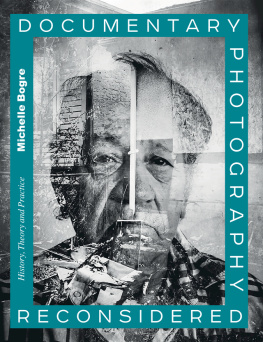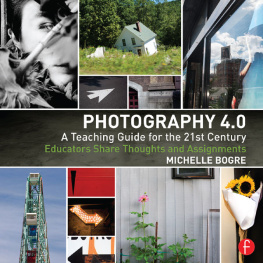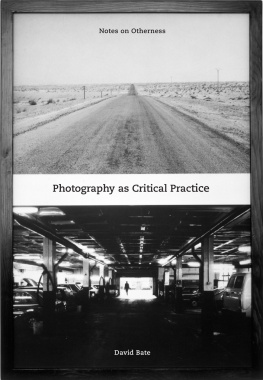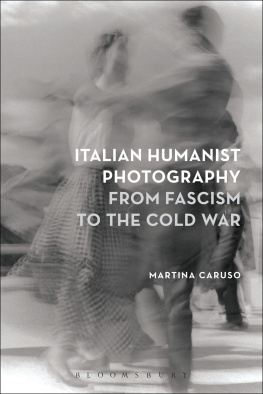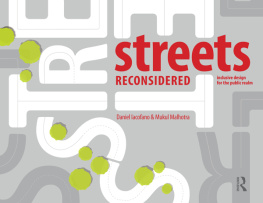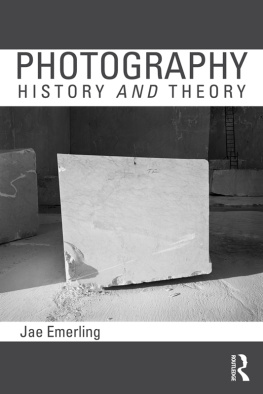DOCUMENTARY PHOTOGRAPHY RECONSIDERED
First published 2019 by Bloomsbury Academic
Published 2020 by Routledge
2 Park Square, Milton Park, Abingdon, Oxon OX14 4RN
605 Third Avenue, New York, NY 10017
Routledge is an imprint of the Taylor & Francis Group, an informa business
Copyright Michelle Bogre, 2019
Cover design: Irene Martinez Costa
Cover image Daniella Zalcman
All rights reserved. No part of this book may be reprinted or reproduced or utilised in any form or by any electronic, mechanical, or other means, now known or hereafter invented, including photocopying and recording, or in any information storage or retrieval system, without permission in writing from the publishers.
Notice:
Product or corporate names may be trademarks or registered trademarks, and are used only for identification and explanation without intent to infringe.
A catalogue record for this book is available from the British Library.
Library of Congress Cataloging-in-Publication Data
Names: Bogre, Michelle, author.
Title: Documentary photography reconsidered: history, theory and practice / Michelle Bogre.
Description: London; New York: Bloomsbury Visual Arts, an imprint of Bloomsbury Publishing, Plc, 2019.
Identifiers: LCCN 2018030856 | ISBN 9781472586698 (pbk.: alk. paper) | ISBN 9781350031647 (epub) | ISBN 9781472586704 (ePDF)
Subjects: LCSH: Documentary photography.
Classification: LCC TR820.5 .B653 2018 | DDC 770dc23 LC record available at https://lccn.loc.gov/2018030856
Typeset by Lachina Creative, Inc.
ISBN 13: 978-1-4725-8669-8 (pbk)
Documentary Photography Reconsidered
HISTORY, THEORY AND PRACTICE
MICHELLE BOGRE

DEDICATION
This book is dedicated to all of the worlds documentary photographers because they show us what we must see.
DISCLAIMER
The author and publisher gratefully acknowledge the permission to reproduce the copyright material in this book. Every effort has been made to trace copyright holders and to obtain their permissions for the use of copyrighted material. The publisher apologizes for any errors or omissions and would be grateful if notified of any corrections that should be incorporated in future reprints or editions of this book.
CONTENTS
STEPHEN MAYES
Guide
This book would not have been possible without the support and encouragement of my friends and colleagues in the documentary world. I am deeply indebted to everyone who graciously met with me and shared ideas about documentary photography in thoughtful, challenging, and often provocative conversations. You are all exceptional. A book on documentary photography must have great photographs, so a very special thank you to all of the photographers whose brilliant photographs grace the pages of this book. I am honored to call many of you my friends. I am indebted to Michelle Achino and Baptiste Lignel, who read the manuscript at various stages and whose perceptive comments improved my writing and my thinking. All authors are dependent on a skilled production team, so my deep gratitude to Julie Grahame, Jack Salazar, Richard Wade, Sophie Barkham, and the editors and staff at Bloomsbury Press, particularly Georgia Kennedy, who enthusiastically embraced the idea for this book, and Sophie Tann, who marshalled it to print. Finally, to my husband, Peter, for his patience and belief in the value of this book.
SPEAKING OF PHOTOGRAPHY
StephenMayes
This book is dedicated to photography. It offers a necessary reflection on the medium at a moment of anxiety and excitement, as we transition from a world of relative certainty about the purpose and process of the visual image, to a world of unknown possibility with all the attendant uncertainties of opportunity and risk. Read contemporaneously, these chapters present a rich analysis of the photographic history that brought us to this point and they offer strong theoretical and practical guidelines to how we might navigate the next steps. Read in years to come, the book stands as a marker of a historic moment when culture changed, revealing in retrospect how far we are from understanding what we are actually talking about. The images will be the same when viewed from a distant future, but how we understand them will be very different; our conceptual notions of photography and even of truth will be based in alternate paradigms of reality. So, although this is a book about photography, really its a book about words: how do we talk about imagery, what is our conceptual framework, and how do we describe what we look at?

